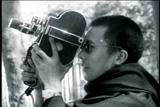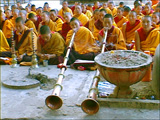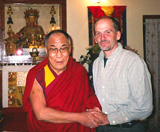| Despite its tedious title, ‘10 Questions’ is anything but a tedious film By JEANNETTE CATSOULIS NY Times News Service, NEW YORK When the filmmaker Rick Ray arrived in India to direct a travel video, an interview with the Dalai Lama was supposed to be part of his compensation. When he discovered that he would have to arrange it himself, he did, by e-mail. The result is 10 Questions for the Dalai Lama, a tedious title for an anything-but-tedious film. Expertly merging the mystical and the mundane, Ray presents a warm and well-rounded portrait of his subject, his Buddhist philosophies and the painful circumstances of his exile to a modest monastery in Dharamsala, India. Though it touches on Tibet and China’s discordant political history (with amazing archival film and an interview with a former Chinese political prisoner), the movie is more charmed by the Dalai Lama’s personality than by his politics. Impish, self-deprecating and an infectious giggler, he is an unorthodox spiritual exemplar with an insatiable scientific curiosity. (“When science contradicts faith, he’s prone to choose science,” Ray marvels.) This 14th incarnation of the Dalai Lama would rather be reading about neuroscience than enduring a festival in his honor. As for Ray’s questions, his interviewee doesn’t hold back, whether discussing his environmentalism or the outmoded Indian caste system. He even ventures onto the thin ice of birth control. “Quality is more important than quantity!” is his emphatic opinion. Mother Teresa might have had something to say about that. | |
| FILM NOTES 10 QUESTIONS FOR THE DALAI LAMA DIRECTED BY: Rick Ray STARRING: The Dalai Lama RUNNING TIME: 85 MINUTES TAIWAN RELEASE: TODAY
| |
 PHOTO COURTESY OF DOUBLE EDGE ENTERTAINMENT |  PHOTO COURTESY OF DOUBLE EDGE ENTERTAINMENT |
 PHOTO COURTESY OF DOUBLE EDGE ENTERTAINMENT | PHOTO COURTESY OF DOUBLE EDGE ENTERTAINMENT
|
PHOTO COURTESY OF DOUBLE EDGE ENTERTAINMENT
| PHOTO COURTESY OF DOUBLE EDGE ENTERTAINMENT
|

One of the biggest sore spots in Taiwan’s historical friendship with the US came in 1979 when US president Jimmy Carter broke off formal diplomatic relations with Taiwan’s Republic of China (ROC) government so that the US could establish relations with the People’s Republic of China (PRC). Taiwan’s derecognition came purely at China’s insistence, and the US took the deal. Retired American diplomat John Tkacik, who for almost decade surrounding that schism, from 1974 to 1982, worked in embassies in Taipei and Beijing and at the Taiwan Desk in Washington DC, recently argued in the Taipei Times that “President Carter’s derecognition

This year will go down in the history books. Taiwan faces enormous turmoil and uncertainty in the coming months. Which political parties are in a good position to handle big changes? All of the main parties are beset with challenges. Taking stock, this column examined the Taiwan People’s Party (TPP) (“Huang Kuo-chang’s choking the life out of the TPP,” May 28, page 12), the Democratic Progressive Party (DPP) (“Challenges amid choppy waters for the DPP,” June 14, page 12) and the Chinese Nationalist Party (KMT) (“KMT struggles to seize opportunities as ‘interesting times’ loom,” June 20, page 11). Times like these can

JUNE 30 to JULY 6 After being routed by the Japanese in the bloody battle of Baguashan (八卦山), Hsu Hsiang (徐驤) and a handful of surviving Hakka fighters sped toward Tainan. There, he would meet with Liu Yung-fu (劉永福), leader of the Black Flag Army who had assumed control of the resisting Republic of Formosa after its president and vice-president fled to China. Hsu, who had been fighting non-stop for over two months from Taoyuan to Changhua, was reportedly injured and exhausted. As the story goes, Liu advised that Hsu take shelter in China to recover and regroup, but Hsu steadfastly

You can tell a lot about a generation from the contents of their cool box: nowadays the barbecue ice bucket is likely to be filled with hard seltzers, non-alcoholic beers and fluorescent BuzzBallz — a particular favorite among Gen Z. Two decades ago, it was WKD, Bacardi Breezers and the odd Smirnoff Ice bobbing in a puddle of melted ice. And while nostalgia may have brought back some alcopops, the new wave of ready-to-drink (RTD) options look and taste noticeably different. It is not just the drinks that have changed, but drinking habits too, driven in part by more health-conscious consumers and